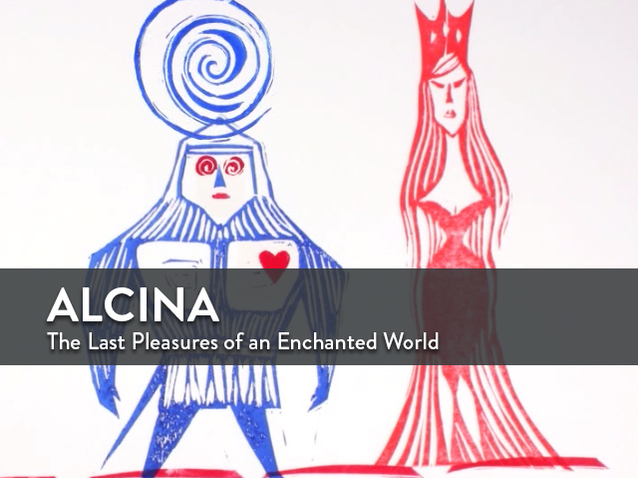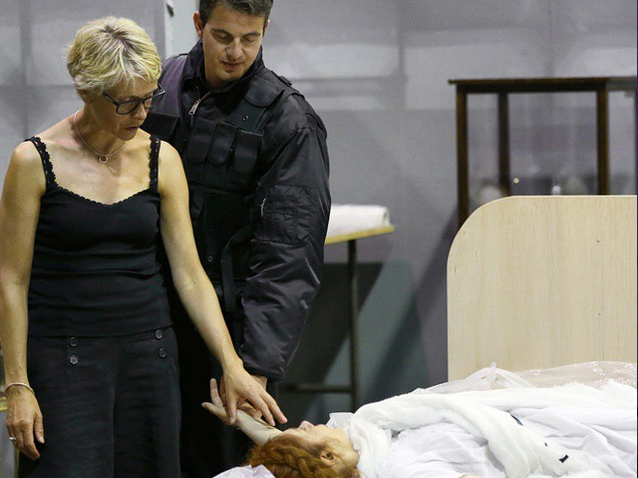 © DR
© DR
This year, a new production of Alcina, the « magical » opera written by Handel, is given for the opening of the Aix-en-Provence Festival, with Patricia Petibon singing the role-title alongside Philippe Jaroussky and Anna Prohaska.
The occasion to (re)discover the enchanting work by the Germano-British composer, talking about freedom as well as bewitching seduction against true love, being maybe quite representative of its era. As the illusive world of the sorceress Alcina fades progressively into the reality, the work of Handel (his last major success) marks the turn of the british lyrical scene of the time. Many problems that we study to better understand the opera and its context at the eve of the 2015 Aix-en-Provence Festival.
***
Alcina holds a unique place in Handel’s career (1685-1759). Of his forty operas, the fourth summons up spells from enchanted worlds ruled by an enchantress.It was the third one whose subject matter was taken from Orlando furioso, the famous poem written by Ariosto in the early 16th century.It was the second one written for audiences at the new Covent Garden Theatre, which opened in 1732. And, finally, it was the composer’s last great London success.It ran for 18 days, a remarkable achievement for the time.Like Alcina, the seductive and ever-changing sorceress transformed by love, Handel is in a bewitching musical world that lends itself readily to all the spectator’s expectations:Alcinacan be viewed as a mere baroque divertissement, a very successful example of a “magic” opera, generally making use of special effects.The work can also be seen as a moral allegory on the danger of easy pleasure.Or perhaps as the reassuring triumph by a pair of mortals over the deceptive powers of magic?It is also a paean to love and freedom won back.While attending a rehearsal of Alcina at Handel’s house, a loyal friend of the composer, a Mrs Pendarves, exclaimed rapturously over this opera:“The best (Handel)ever made (…), it’s so beautiful I have no words to describe it…. As Mr Handel played his part, I could not help imagining him as a necromancer in the middle of his own spells.”The love Alcina feels for Ruggiero ends up stripping her of her magic powers by making her the prisoner of her own desires.She disappears, vanquished by the courage and constancy of her rival Bradamante, who, it turns out, is not a mere mortal.The enchanted world evaporates when Ruggiero breaks an urn containing the fairy’s powers, and everything returns to normal.Alcina was the last enchantress written by Handel.While the “opera seria” world was cracking open to allow room for comedic opera, Alcina was slipping away, taking with her one of the last pleasures of an enchanted world. Handel gave up opera five years later with Deidamia (1741). Turning away from the theatre, he devoted himself primarily to the oratorio, producing huge masterworks one after another, first his renowned Messiah (1742) and then, a few months later, Samson (1743).
The Turbulent Career of a Man of the Theatre
After the success of Rinaldo (1711), Handel settled in London where he achieved a career as brilliant as it was turbulent in the changing world of London opera.The founding of the Royal Academy of Music in 1719 provided him with a unique venue.With the creation of this musical society set up in King’s Theatre in Haymarket, Handel managed to earn a name for himself with operas like Radamisto (1720), Tamerlano (1724) and Rodelinda (1725). But artistic and political cabals added to the public’s capriciousness finally got the better of this lovely adventure, conducted with panache by Handel, the indefatigable man of the theatre.
When he reached the end of his contract binding him to King’s Theatre, Handel had to give up his theatre… only to experience the extreme displeasure of seeing his direct competitor ushered in, the “Opera of the Nobility”, founded three years earlier by the Prince of Wales who was determined to support a rival, more seductive and dynamic troupe than Handel’s.The prince gained a decisive advantage by recruiting the famous Neapolitan composer, Porpora.He did not hesitate to lure away the performers responsible for the glory days at King’s Theatre, including Senesino, the famous castrato.He also engaged a star of the time, La Cuzzoni, and a young talent with a dazzling future, Farinelli.
Could competition like that put an end to the energy and determination Handel had always demonstrated?That would be to misunderstand a man who never stopped using his endless talents as composer, conductor and impresario to impose his aesthetic choices on a passionate and at times partisan London audience. On 8 January 1735, Handel presented Ariodante at the brand-new Covent Garden Theatre, where he gathered together his last faithful followers in order to successfully rival the Opera of the Nobility troupe.The new theatre, opened in 1732, was built at the top of Bow Street on the site now occupied by the Royal Opera House. The composer used all the artistic resources the circumstances offered, like the presence of famous dancer/choreographer Marie Sallé, who had been made artist-in-residence at Covent Garden by director John Rich.Unfortunately, Ariodante was a flop, and a few days later Alcina, created a few months later, became Handel’s greatest success; all his operas were to gradually disappear from the London scene.
The Irresistible Attraction of the Adventures of a Seductive Enchantress
After the failure of Ariodante, Handel immediately went back to work with a desire to choose his best subject, more attractive and more spectacular.What better than a “magic” opera, enhanced with supernatural effects to regain the upper hand in this ceaseless rivalry between competing theatres?He chose to put to music an anonymous adaptation of the libretto from L’isola di Alcina (1728) written by Antonio Fanzaglia for Farinelli’s brother, composer Riccardo Broschi (1698-1756).The plot and characters have their origins in the sixth and seventh Cantos of Ariosto’s epic poem, Orlando Furioso (1505-1532).Audiences at the time knew these chivalrous plots by heart, as part of a common cultural foundation.While the libretto used by Handel shows some variations in regard to the tradition, he includes most of the characteristics of the Alcina character, the formidable sorceress who uses her powers to bewitch warriors whom she keeps prisoner in her enchanted island.After making them her lovers, she turns these careless men into stone or wild animals as soon as she tires of their presence.The knight Ruggiero falls under her sway, just like the others.He soon forgets his past and the love of his faithful Bradamante, who does not hesitate to win him back with the help of her former tutor, Melisso.Disguised as a man, Bradamante manages to escape Alcina’s vigilance, with Ruggiero turning his back on her.The reign of Alcina and her sister Morgana comes to an end, thanks to the courage of Bradamante who saves Ruggiero from a morbid passion.From 1625 to the dawn of the 19th century, many operas were written with Alcina as heroine.The myth of the sorceress who casts a spell on the hero and lures him away from his mission originated with Homer.In The Odyssey, Ulysses spends ten years with Calypso.He too is held prisoner on the island of the enchantress Circe, who turns the hero’s comrades into pigs.There was also Aeneas: Virgil tells of the separation from Dido, who wants to keep him in Carthage, whilst fate is calling him to other shores.
Describing the wanderings born out of Alcina’s spells gives Handel an opportunity to use some very sophisticated machinery that the new Covent Garden Theatre lacked.In the eyes of London audiences, he was already considered a specialist of the wondrous.For Handel seems to have greater use of “special effects” at the time than anyone else since the era of the King’s Theatre.The first three enchantresses he put on stage benefited from the finest theatrical setting.In Rinaldo (1711), Armida entered on a chariot drawn by two dragons.In Teseo (1713), the mid-performance set changes allowed Medea to turn a desert into an enchanted isle.In Amadigi di Gaula (1715), audiences saw a “fountain of truth”, demons and knights, and the sorceress Melissa turned the stage into a cave filled with monsters and Furies. In the second scene of Alcina, we hear:“…the din of the thunder and lightning which, striking unexpectedly from several sides, destroys the mountains; as they collapse, Alcina’s beautiful palace”.Today we can only imagine all those stage and musical effects that delighted 18th century audiences in order to get an accurate idea of these works.
But to summon up wondrous spells, Handel did not just make use of spectacular sets made to move by ingenious machinery, as evidenced by the beauty and elegance of his score.Hence Ruggiero’s two arias that open the second act of Alcina highlight his release from the spell that enables the hero to break free of Alcina’s clutches just as the “machines” do. Between the first and second arioso, Melisso, the wizard who kidnapped Ruggiero, uses white magic against Alcina.A ring slipped on Ruggiero’s finger is sufficient to open the eyes of the paralysed lover.We see the room in Alcina’s castle transform into a “horrible and deserted place”, and we hear Ruggiero go from plaintive and languorous (“Col celarvi a chi v’ama”) to a song expressing amazement:“Qual portento”.The magic of the sounds and the voice depict the sudden and welcome reversal:Ruggiero forgets the enchantress and thinks only of Bradamante, the legitimate fiancée he chased out of his heart.
After a two-century eclipse, the real rebirth of Alcina’s character came in 1957.In a production put on in London by the Handel Opera Society, the great Joan Sutherland, nicknamed “La Stupenda”, gave an extraordinary interpretation of the role.She played Alcina many, many times, making Alcina the most frequently staged of all Handel’s operas after Giulio Cesare. Two other productions marked the history of the work:the production in Aix-en-Provence, in 1978, with Christiane Eda-Pierre and Teresa Berganza; and the one at the Palais Garnier, in 1999, with Renée Fleming and Susan Graham, with William Christie directing.
How the Enchantress Turns into a Jilted Lover
Of the four enchantress characters created by Handel, Alcina seems the most captivating, as she is also the most moving.This character perfectly illustrates the composer’s complete and utter mastery of the art of painting characters.She retains many of the traits of those who preceded her: Armide, Medea and Melissa.It is, first and foremost, a soprano voice.She is as familiar with fury as the other enchantresses are, threatening and vindictive when they feel betrayed.As happened to the other three, she gives us a glimpse into her sensitive soul when she is trapped between the desire for vengeance and the pain of not being loved.Alcina is lost because she allowed herself to be transformed by love.She who turns the lovers she tires of into stone and animals but makes a fatal mistake for an enchantress:she falls in love with the knight Ruggiero, whom she wants to keep close to her, in her human form.And the more Ruggiero works to free himself from her spells, the more Alcina loses her seductive power.

But, paradoxically, she tightens her grip on the listener even more, as the beauty of her singing keeps growing.Of the six “arias” Handel bestows upon her (two per act), Alcina comes out of it more human, because of the ambivalence of her feelings.We get the impression that the composer is trying to describe, through the enchantress’s song, all the nuances of amorous feelings that shape her gradually, giving her a new dimension.Handel captures all the changes in her amorous moods.In Act 1, her initial aria, “Di’, cor mio”, expresses all the tenderness of a love-struck seductress.In the following aria, “Si, son quella”, she proves persuasive by responding with an insinuating sweetness to the reproaches of Ruggiero, who suspects she is infatuated with Ricciardo, who is Bradamante in disguise.In Act 2, Alcina changes tone in the face of Ruggiero’s betrayal:“Ah, mio cor” is one of the highlights of the work.To an almost monotonously regular accompaniment, the enchantress’s voice resembles a succession of broken outbursts emphasised by a searing question:“Why?”. Alcina is torn between disappointment and rage.The second aria, “Ombre pallide”, expresses desperate resignation in the face of the silence of the internal spirits, who no longer respond to the enchantress now that she is deprived of her supernatural powers.In her first aria in Act II, “Ma quando tornerai”, we again encounter all the character’s contradictions:impotent fury and invincible sadness share her tormented heart.The passionately melodic line expresses a desire to yet believe in the love of Ruggiero, won back by his fiancée Bradamante.The abject resignation of the final aria, “Mi restano le lagrime” leads to a desire to disappear “into the clear waves”, to “turn oneself into a rock” to escape the pain.Alcina is prepared to accept death serenely, but she remains an immortal fairy, and this succor is denied her.All that is left for her is lying to the reunited lovers, Ruggiero and Bradamante.But they can no longer be seduced by the enchantress’s artifices as her world collapses under the weight of the love that binds these two mortals.
With this gradual loss of power, Ruggiero gains freedom as he says goodbye to the delightful enchantments that first bewitched his inconstant heart.In Act III, in a highly virtuoso aria, the perfect illustration of Handelian bel canto, Ruggiero bursts out triumphantly and with panache (“Sta nell’ircana pietrosa tana”). He has detached himself from the formidable Alcina to rediscover his true identity, that of a conquering warrior, sure of himself.This means Alcina can be read as an allegory.An anonymous spectator wrote in the Universal Spectator, a newspaper founded in 1728 by Daniel Defoe and Henry Baker, that he saw in the work “a fine and instructive allegory” intended to prove that “neither the counsel of friends nor the example of others (…) can keep the feckless and stubborn young man from seeking out imaginary or fleeting pleasures”.
The role of Ruggiero was created by the famous castrato Giovanni Carestini (1705-1760, Farinelli’s rival.The score gave him more than one opportunity to demonstrate his extreme virtuosity.However, he considered rejecting one of the loveliest of Ruggiero’s arias, which he felt was unworthy of his immense talent.A lovely, melancholic meditation of a fluidity and simplicity that remind one of Mozart’s art, “Verdi prati” (Act II, scene 12), in no way stands out for its technical difficulty.But this aria holds universal value, because it manifests Ruggiero’s farewell to the enchanted world that so deliciously seduced him:“Green prairies, lovely forests, You will lose your beauty.And when flattering appearance is gone, To your first honour, All will come back to you”.This farewell to the last pleasures of an enchanted world expresses all the regret of men in the face of the finiteness of beauty inexorably fades away.Nothing withstands the withering onslaught of time.Only Alcina’s artifices could momentarily transform charmless reality into a seductive place, magnified by beauty.Like the artist who can turn the commonplace into an enchanted world where everything makes sense, Alcina knew to surround herself with the most wondrous appearances.Her end also brings the opera to an end and announces the end of Handel’s inspiration, fading from the opera scene like its unhappy heroine.
Catherine Duault
the 26 of June, 2015 | Print

Comments